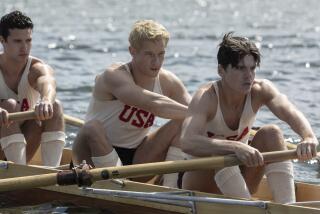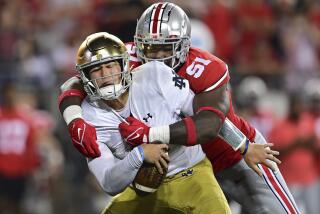Oxford: Where Sport Is Still Played for Fun : After 800 Years, Scholarship Continues to Count for More Than Rowing or Rugby
- Share via
OXFORD, England — The 35 colleges that make up Oxford University are spread so far around this old town you need a taxi and a couple of days to see them all--if you can find them. Professors who have taught here for years have been known to get lost trying to find an unfamiliar one.
Natives can easily identify Christ Church, the most famous of the colleges, but when a reporter sought directions to the Athletic Union he got no help until a young woman pointed to a lane that led from Iffley Road to a small gymnasium and said: “I think it is over there somewhere.”
The woman was right. The headquarters for all of sports at one of the world’s most important universities are two small offices in a small gymnasium.
The entire gymnasium wouldn’t even hold the athletic department of most major U.S. colleges.
What Oxford sports lack in amenities, however, they make up for in longevity and tradition. To give you an idea, the first rowing races were held in 1815, when the university was only about 650 years old.
One quickly gets the idea that scholarship has priority at Oxford. Students control their own sports, coaches work for the fun of it instead of salaries, the best athletes don’t always get into school and, if they do, they pay their own way.
There are no such things as athletic scholarships at Oxford and only a few coaches get expenses. The way sports are run at Oxford makes the Ivy League look like the National Football League.
“The rewards are very small here,” said Jim Railton, secretary of the Sports Committee. “Most coaches work for nothing. We’re very amateurish compared to the United States.”
Railton functions somewhat like a U.S.-type athletic director. He is also the rowing consultant and correspondent for The Times of London.
Oxford and equally famous Cambridge University skim off the top 5% of the nation’s best scholars, leaving little room for ordinary jocks. “It is terribly hard for even the best athletes to get in here,” Railton said. “If Carl Lewis came here with his four Olympic gold medals, he probably couldn’t get in.”
London’s daily newspapers virtually ignore sports at Oxford and Cambridge. “The boat race is the only event that means anything,” said Adrian Brown, deputy sports editor of the Daily Mirror. “The boat race,” a visiting reporter was supposed to know, is the one every spring between Oxford and Cambridge.
Railton seemed amused when he was asked to comment on the meager attention Oxford sports get in the London papers. “Sports are quite civilized here; we’re quite different from you Americans,” he said.
A tall young fellow in an Oxford blue warm-up suit dropped by to chat with Railton for a moment, sounding like a PhD. Watching him leave, Railton said: “He is one of our best athletes, a rower. He’s a doctor and is on his way to work in Bolivia.”
Kings, princes, earls, lords and prime ministers and their sons have been playing games at Oxford for 150 years. Teams have also featured such Rhodes Scholars as Supreme Court Justice Byron (Whizzer) White, U.S. Senator Bill Bradley, Army General Pete Dawkins and Los Angeles lawyer Pat Haden.
On an otherwise undistinguished running track that could be seen through a window behind Railton’s desk, Roger Bannister became the first human to run a mile in less than four minutes. The date was May 6, 1954. Today, Sir Roger Bannister is a much respected doctor who soon will become head of college--that’s the No. 1 job--at Pembroke, one of Oxford’s 35 colleges.
Hollywood, at least twice, has made films about sports at Oxford, first with Robert Taylor in “A Yank at Oxford,” and more recently with the dreadful “Oxford Blue,” a story about an obnoxious Yank oarsman.
Oddly, sports at Oxford are divided into “full blue,” the major games, and “half blue,” the minor ones. Among the major sports are soccer, track and field, basketball, boxing, golf, hockey, tennis, rowing, rugby, swimming and yachting.
You see a lot of blue around Oxford. According to Railton, the use of the color to distinguish between sports stems from the first boat race in 1829. Legend has it that the winning Oxford oarsmen wore uniforms of dark blue, the color made famous by Christ Church students. Cambridge’s rowers wore pink sashes, the story goes. Anyway, Oxford’s color has been blue ever since and a blues committee rules all sports here today.
The major sport is rowing. The boat race from Putney to Mortlake on the Thames River, a distance of 4 miles 374 yards, is televised by the BBC and attracts about 12 million viewers. London bookmakers put out odds on the race.
“Bumping” boat races are popular, too. Held in the summer, they last four days and draw crowds of 25,000. At the sound of a cannon, boats take off, 1 1/2 lengths apart. The trick is not to get bumped by the boat behind you. If a boat is bumped, it must drop back and is replaced by the one that bumped it.
There is nothing in U. S. college sports to compare with rowing at Oxford. The oarsmen are members of the Boat Club and its president chooses his own coaches. “If he’s sensible and has a good crew, he’ll keep the same coaches,” Railton said.
For the first time in history, the president of the Boat Club this season is a former Cambridge oarsman who transferred after being on the losing crew three straight years. Last spring he helped beat his old teammates.
Neither college has dominated the big race over the years. “It’s an intense rivalry but it comes and goes,” Railton said. An American stroked the Oxford crew last season and two Yanks are expected to make the boat this year. Oxford will row against UCLA in Los Angeles next April.
Rowing coaches, thanks to the clout of their sport, frequently get expense money, Railton said. “But most just enjoy the job.”
Sports may be more civilized at Oxford than at U.S. colleges, but its rivalry with Cambridge is as tense as USC vs. UCLA.
“The winning-is-everything philosophy does exist when Oxford plays Cambridge,” Railton said. “Sometimes athletes break down and cry when they lose. It’s the glare of television, I think. I’ve seen athletes who would never speak to each other again after a race.”
Cricket and rugby are almost as popular as rowing, but soccer does not get the attention at Oxford that it does in the professional league. The university’s big match with Cambridge draws only about 7,000 spectators to London’s Wembley Stadium. Rugby, on the other hand, draws about 35,000.
Surprisingly, basketball has become a popular sport here, mainly because of Bill Bradley. It is hard to tell how well cricket draws because matches run from 11 a.m. until 8 p.m. and students drift in and out. Some games, in fact, last two days.
Each of the 35 colleges has its own athletic teams and the intramural games often are quite noisy affairs, Railton said. The best athletes, of course, move up to the varsity. All the colleges have their own stadiums and arenas and do not use the university’s grounds and gymnasiums.
Remarkably, Oxford has no budget for sports. It underwrites only the cost of the facilities. Each of the 12,671 students, 4,630 of them women, pay a $3.50 fee to a central athletic fund, which is divided among the poorer sports.
“We’re in poor financial health,” Railton said. “There isn’t a great deal of money to spread around.” There would be even less, in fact, if it wasn’t for “a benefaction”--translation: endowment--from the Rhodes trustees. Cambridge has no such fund and as a result, it has fewer and more modest athletic facilities.
The major sports are financially independent because they have commercial sponsors. A bank sponsors the rugby team, the soccer team gets a grant from the professional league, and a bookmaker, Ladbrokes, sponsors the rowing team.
Oxford is a coeducational institution, women having been admitted in force in 1974. However, there have always been all-female colleges in the Oxford cluster and two remain today.
The university, founded in the mid-12th Century, is 60 miles and about an hour’s train ride from London. Students and the townspeople did not get along in the early days. There were frequent fights, which became famous as the Town and Gown Riots. In 1354, for example, they fought for two days with bows and arrows. Many students were killed.
Politicians at Oxford join the Oxford Union, actors hope to get into the drama society, and athletes, if they are lucky, join the Vincent’s Club. The club, founded in 1863, once admitted only Oxford’s finest 100 athletes, all males, through “elitism and careful selections.” Two kings, Edward VIII of Britain and Olaf of Norway, two prime ministers and two Japanese princes managed to get invited to the exclusive club.
The old Blues still gather to drink and talk in their small quarters off High Street, Oxford’s main thoroughfare. Photos of athletic kings and prime ministers are on the walls. So is a rugby ball autographed “With thanks” by Pete Dawkins.
There is less exclusivity today, however. Membership has risen to 250, possibly because of less elitism and fewer careful selections. Membership is still exclusively male but women are allowed in the clubhouse in the evening.
Oxford’s modest approach to sports would never sell in the United States. Alumni would never go for it. On the other hand, bumping races seem a lot more exciting than swimming or golf, and the idea of giving scholarship priority over games might just catch on some day.
More to Read
Sign up for Essential California
The most important California stories and recommendations in your inbox every morning.
You may occasionally receive promotional content from the Los Angeles Times.













